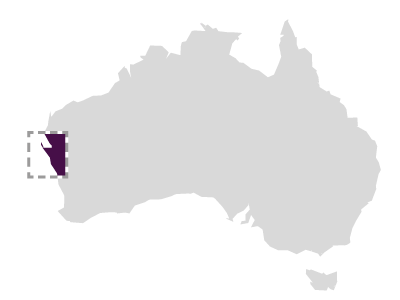Two Whaleboats Grey expedition (1839/03/31)
Ganthaume Bay, Kalbarri

The whale-boats used by George Grey during his expedition to explore the Western Australian coast in February 1839 were typical of those found in many places around the world. The drawing ‘Attack of Natives Near Kolaina Plains. Drawn on stone by Geo. Barnard from a Sketch by Fredk. C. Smith Esq’ Shows one of Grey’s boats on the beach (Grey, 1983 [1839]: 377).
Whale-boats were lightly built of 13 mm planking (cedar in the case of most American-built boats). Weighing about 900–1 000 lb (400–450 kg), they were capable of carrying 1?000 lb (450 kg) of stores plus a normal crew of six men, one steering and five rowing. They were cheap and quick to build and, when used by whaling vessels, were not expected to have a long life. Repairs were often carried out aboard ship, but just as often the boats would be abandoned as too badly damaged, or perhaps sold locally before the whaler headed home at the end of the voyage. Whale-boats were seaworthy, manoeuvrable and capable of withstanding hard usage. The whale-boats from the Nantucket whaler Essex that was sunk by a whale in 1820 were sailed and rowed over 3?700 km in the eastern Pacific Ocean before the crew were rescued.
From Willits Ansel comes the following description:
The boats used in sperm whaling in the 1830s and 1840s were light, shallow, lapstrake, double-ended boats with strong sheer and raking ends. Forward they had bow chocks, warp box, and thigh board with clumsy cleat. There were five thwarts for the men pulling the long, single banked oars, three on the starboard and two on the port side. Aft was the cuddy board and loggerhead, which tended to rake aft in earlier boats. The steering oar was on the port side of the stern post (Ansell, 1983: 14).
THE LOSS
George Grey had left Fremantle on 17 February 1839 aboard the American whaler Russell, (302 tons, Captain George B. Long) of New Bedford, to continue his exploration of the Western Australian coast. He had procured three whale-boats for this task. Grey and his party of 11 together with their boats, food and other supplies, were disembarked on Bernier Island on 25 February. Two days later he lost his first boat, named the Paul Pry, when a storm arose and it was washed side on to the beach and broken up by the surf. Grey also lost half a ton of stores that were in the boat. More importantly he also lost most of the cache of stores he had previously buried on Bernier Island.
After some exploration of the coast and islands the party departed Shark Bay through South Passage, arriving at the northern extremity of Ganthaume Bay at 10 a.m. on 31 March 1839. They sailed the two boats the length of the bay searching for a suitable landing place where fresh water might be obtained. A site was chosen and, with Grey at the steering oar, the first boat attempted a landing through the heavy surf. The boat landed on rocks that had unfortunately not been seen from seaward, and was badly damaged. Grey and his boat crew endeavoured to get their damaged boat and its stores ashore as quickly as possible. The crew of the second boat had not seen the accident because high waves shut out their view. Seeing Grey’s men haul the whale-boat ashore, they presumed that conditions were suitable for landing. Consequently they also attempted to land but at a site slightly further south. Grey tried to warn the crew of the other boat but was unsuccessful. The second boat was also damaged when it struck the shore, some planks being split for their full length.
The expedition carpenters could not repair either boat, but even had this been possible Grey had decided to abandon them as he considered it would be impossible to launch them through the heavy surf. There was no alternative but to begin the long trek to Perth.
INITIAL SALVAGE
Grey and his party salvaged little in the way of supplies, 20 lb (9 kg) of damaged flour and one pound (0.45 kg) of salt pork per man being all they could save.
EXCAVATION AND ARTEFACTS
Discoveries in 1995 and 2005 of artefacts in the sand-hill at the back of the beach between the Blue Hole and the Kalbarri townsite are probably associated with the loss of Grey’s whale-boats. In 1995 lead shot weighing 1415.5?g was discovered, and in 2005 the Museum recovered a further 74.2 g of lead shot and a lead artefact covered in iron rust and weighing 10.5 kg at the same site. The lead shot was of two sizes, the larger averaging 10 mm in diameter and the smaller averaging 7 mm in diameter. On some there was evidence of having been in a mould while some have sprues. Two sites containing bones were also located nearby.
Because of the position of these discoveries close to the beach where Grey’s whale-boats are thought to have come ashore, it is probable that the artefacts will prove to be associated with his expedition. However at this stage there is no direct evidence of a link.
Ship Built
Master George Grey
Ship Lost
Grouped Region Mid-West
Sinking Wrecked on beach
Crew 12
When Lost 1839/03/31
Where Lost Ganthaume Bay, Kalbarri
Latitude -27.727937
Longitude 114.153127
Position Information 2005GPS
Port From Shark Bay
Port To Fremantle
Ship Details
Length 8.59
Beam 1.92
Museum Reference
Unique Number 983
Sunk Code Foundered
File Number MA3405
Chart Number Aus 332
Protected Protected State
Found Y
Inspected Y
Date Inspected 2005/10/16
Confidential NO